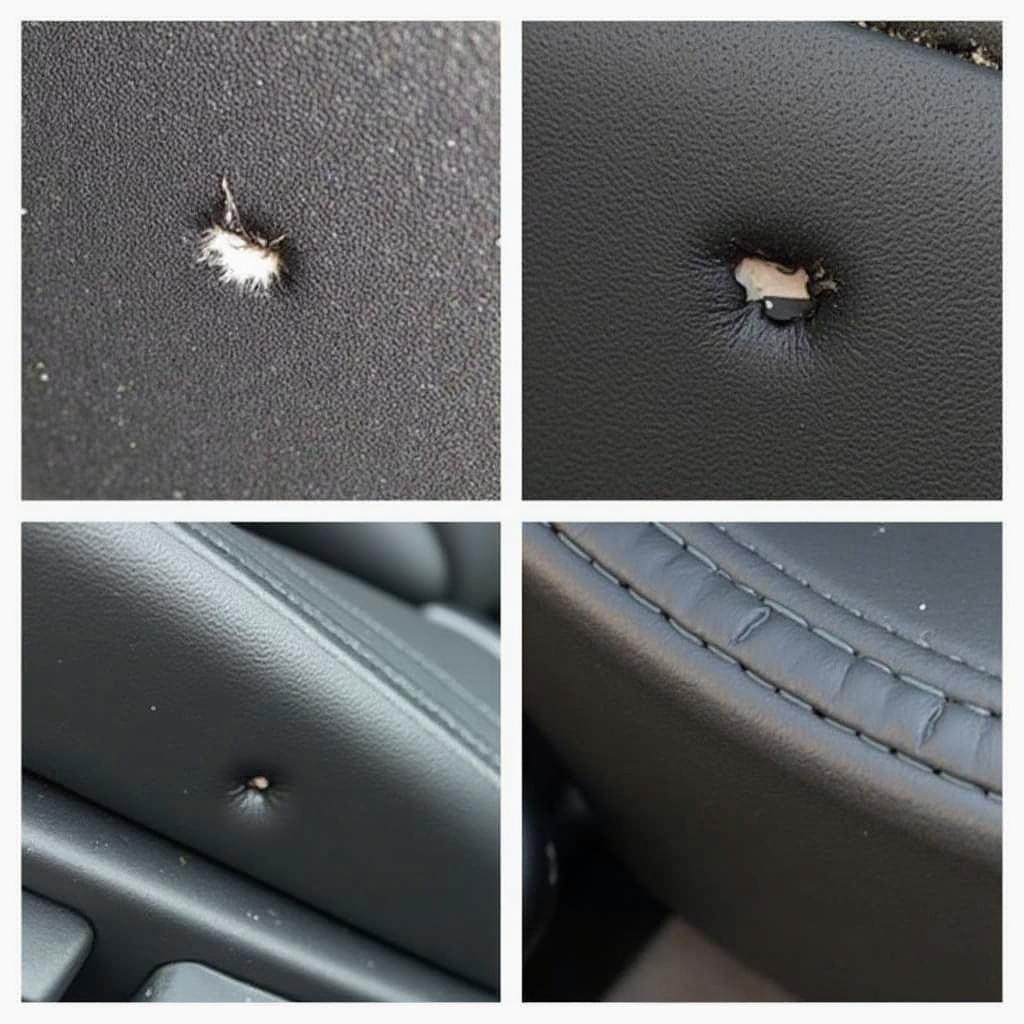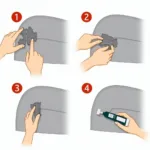Discovering a hole in your car seat can be frustrating, but it doesn’t necessarily require an expensive trip to the auto upholstery shop. Whether it’s a minor burn, a tear, or a larger hole, this comprehensive guide will provide you with practical steps and solutions to effectively repair car seat holes and restore your car’s interior.
Identifying the Hole and Gathering Your Supplies
Before diving into the repair process, it’s crucial to assess the damage and gather the appropriate materials. The repair method and tools you’ll need depend on the size, location, and type of car seat material.
Types of Car Seat Holes:
- Burn Holes: Often caused by cigarettes or dropped embers, burn holes usually affect the fabric’s surface layers.
- Tears and Rips: These can occur from sharp objects, rough use, or general wear and tear.
- Holes from Wear and Tear: Over time, friction and pressure can create holes, especially on the driver’s seat bolster.
 Types of Car Seat Holes
Types of Car Seat Holes
Essential Supplies for Car Seat Hole Repair:
- Cleaning Supplies: A vacuum cleaner with attachments, rubbing alcohol or upholstery cleaner, microfiber cloths.
- Repair Materials: Depending on the hole type and material, you might need a patching kit, leather filler, adhesive, or fabric glue.
- Color Matching: Leather dye, fabric paint, or a matching fabric patch (ensure it’s a close match to your car’s interior).
- Tools: Scissors, a utility knife, a heat gun or hairdryer, tweezers, and a palette knife.
Repairing Small Holes and Burns
For minor damage like cigarette burns or small tears, simple repair methods can effectively restore your car seat’s appearance:
1. Clean the Area: Use a vacuum cleaner to remove debris, then clean the area around the hole with rubbing alcohol or upholstery cleaner and a microfiber cloth.
2. Patching Small Holes:
- If using a patch, ensure it’s slightly larger than the hole.
- Apply fabric glue or adhesive to the back of the patch, carefully aligning and pressing it over the hole.
- Use a heat gun or hairdryer (on low heat) to activate the adhesive and ensure a strong bond.
3. Addressing Burn Holes: - Gently lift any loose fibers around the burn hole using tweezers.
- If the hole is small and superficial, a fabric marker or a dab of matching fabric paint can effectively camouflage it.
- For deeper burns, consider using a leather filler or a vinyl repair kit, following the manufacturer’s instructions.
For more detailed instructions on repairing small burn holes in car seats, refer to our comprehensive guide: how to repair small burn hole in car seat.
Repairing Larger Tears and Holes in Fabric Car Seats
Fixing larger tears or holes in fabric car seats requires a more involved approach:
1. Assess the Damage: Determine if the tear can be stitched together or if it requires a patch.
2. Preparing for Stitching:
- If stitching, use a curved needle and upholstery thread.
- Start from the inside of the tear, pulling the edges together tightly.
- Use a backstitch or slip stitch for a durable repair.
3. Patching Larger Holes: - Cut a patch from matching fabric, ensuring it’s slightly larger than the hole.
- Apply fabric glue to the back of the patch.
- Carefully align and press the patch over the hole from the backside of the fabric.
- Use a heat gun or hairdryer to activate the adhesive and ensure a strong bond.
Repairing Holes in Leather Car Seats
Leather car seats require specific techniques and materials for repair:
1. Cleaning and Preparation: Clean the area thoroughly with a leather cleaner and let it dry completely.
2. Using Leather Filler:
- For holes and cracks, apply a leather filler compound, pressing it firmly into the damaged area.
- Use a palette knife to smooth the surface and create a seamless look.
- Allow the filler to dry completely according to the manufacturer’s instructions.
3. Color Matching and Sealing: - Once dry, use fine-grit sandpaper to level the filled area.
- Apply a leather dye that closely matches your car seat’s color.
- Apply a leather sealant to protect the repair and restore the leather’s natural sheen.
For comprehensive guides on repairing different types of holes in leather car seats, check out:
Preventing Future Car Seat Damage
Preventing future holes and damage can save you time and money in the long run:
- Be Mindful of Sharp Objects: Avoid placing sharp objects on your car seats that could cause tears or punctures.
- Use Seat Covers: Invest in durable seat covers to protect your car seats from wear and tear, spills, and UV damage.
- Regular Cleaning: Regularly cleaning your car seats prevents dirt and grime from embedding into the material, reducing wear.
When to Consult a Professional
While DIY repair methods can be effective for many car seat holes, it’s essential to recognize when professional help is necessary:
- Extensive Damage: If the hole is very large, affects structural components, or if multiple tears or burns are present, consult a professional auto upholstery shop.
- Airbag Deployment: If the hole is near an airbag, do not attempt to repair it yourself. Contact a qualified technician to assess potential airbag system damage.
Conclusion
Repairing a car seat hole yourself can be a rewarding and cost-effective solution for restoring your car’s interior. By following the steps outlined in this comprehensive guide and using the appropriate materials, you can effectively address various types of car seat damage. Remember to prioritize safety and consult a professional if you encounter extensive damage or any issues with your car’s airbag system.


